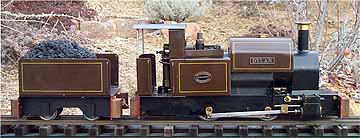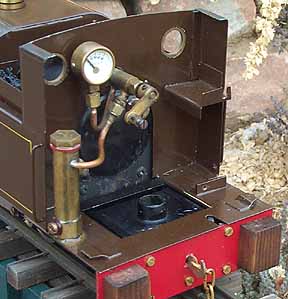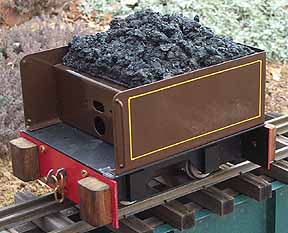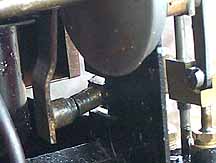
Back to Sidestreet Bannerworks
January 2002
Early Roundhouse Dylan
by Marc Horovitz

Roundhouse Engineering of Doncaster, England, must certainly be the most well-known manufacturer of 16mm scale, live-steam locomotives for gauge 0 and gauge 1 track today. The company, under the direction of Roger Loxley, began production in 1982 with Victoria, a model of a profoundly ugly tram engine from the Plynlimon & Hafan railway. Later that same year, Dylan (named after Roger's dog) emerged.
Dylan is an attractive freelance locomotive. It has small, dummy coal bunkers ahead of, and on either side of, the cab. Forward of these is a dummy saddle tank. A variety of colors was available, including red, green, black, and brown, and all engines were lined out at the factory.
Dylan is a mechanically simple engine. The boiler is a plain, externally-fired pot heated by a four-wick alcohol burner (all Roundhouse engines were alcohol fired in those days). An ample fuel tank resides beneath the footplate and there is a large, uncovered filler hole in the cab. Although this wide opening makes filling a simple matter, it sometimes catches fire, especially in warm weather.
The spartan backhead includes a regulator (throttle) valve, and a pressure gauge. A good-size lubricator stands on the footplate and there is a built-in servo bracket in the cab. The steam line to the cylinders includes a superheater coil above the fire. Reversing is provided by slip eccentrics, the motion being carried through the outside frames by an unusual horizontal rocker arm, a Roundhouse signature.
A four-wheel tender was offered as an optional extra. The front wall of the tender has holes for the on-off switch of a radio and servo wires to the loco. Of course, only the throttle could be radio controlled. Dylan was finally withdrawn from production in 1994.
Performance
From 1984 through 1987 I was Roundhouse Engineering's sole US agent and Dylan was the first engine I imported. At that time I didn't have a track of my own for testing engines, so I took it to Larry Lindsay's track for its first run. I removed the pristine engine from its box, set it on the track, oiled, watered, and fueled it, and lit it up. Sufficient pressure was a long time coming. When it finally arrived, performance was erratic at best and the boiler seemed inexplicably short of breath. This would not do!
A brief examination revealed the problem. The wick tubes had no wicks! All that wick material that I assumed had been included as extra was meant to fill the tubes before the first run. Oh, well. . .live and learn. Once the wicks were properly packed the engine was transformed, and has run beautifully ever since.
For its "Loco of the Month" run, I got Dylan out of mothballs and gave it a good rubdown. It had been 10+ years since I'd run it and, when an engine sits that long, anything can happen. I went through the steaming-up ritual and sat back, awaiting the ascent of pressure. So far, so good. When the gauge showed about 50 pounds, I opened the throttle. Steam burst forth from the right-hand steam chest. The gaskets were shot. What to do? I could be sensible and shut down the engine for repairs before attempting a run or I could proceed. The temperature was around 30 degrees and the atmospherics were wonderful, so we forged ahead. With the throttle opened and a little encouragement offered, the engine sallied forth as if nothing were wrong. Steam jetted copiously from the steam chest. The effect was fabulous. Dylan ran as though in tiptop form, not at all bothered by a trifling catastrophic steam leak.
So, with this engine, the tone was set for the production of Roundhouse's future line of locomotives. Solid engineering and near-absolute reliability became the company's hallmarks, and remain so today.
|
|
|
| Builder | Roundhouse Engineering Company, England |
| Date built | 1984 |
| Gauge | 45mm (gauge 1) |
| Scale | 1:19 (16mm = 1'0") |
| Boiler | Pot |
| Fittings | Throttle, pressure gauge, safety valve |
| Fuel | Alcohol |
| Blow-off pressure | 60 psi |
| Cylinders | Two, double acting, D-valve |
| Reversing gear | Slip eccentric |
| Lubricator | Displacement |
| Dimensions | Length over end beams, 11-7/8" (sans tender); width, 4-3/8"; height over stack, 5-1/2" |






Right: The underside of the engine is straightforward. The superheater coil can just be made out above the wick tubes. Early locos were not regaugeable and had to be ordered in either gauge 0 or 1.


Back to Sidestreet Bannerworks
This page and its contents Copyright Sidestreet Bannerworks, 2002